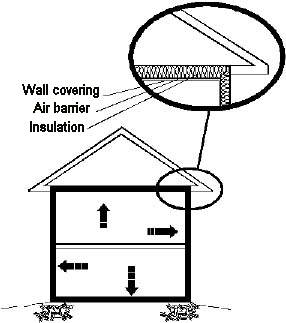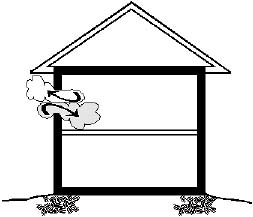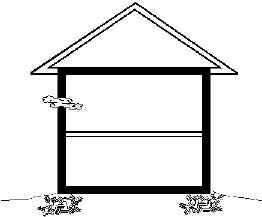Building envelope basics
|
| The
envelope of a building encloses the living space, including the
basement, and isolates the interior of the building from the heat or
cold, and wind outside. Uninsulated attics or crawl spaces are not
considered to be within the building envelope. |
| In
normal wood frame construction, the envelope consists of the lumber
frame with insulation, usually fiberglass, placed between framing
members. The insulation is intended to reduce conductive heat loss or
gain through the envelope. An air barrier covers the frame and insulation
on the inside to reduce air leakage into and out of the envelope. The
air barrier in warm to moderate climate zones is often formed by the
wall covering such as drywall. In colder zones, a polyethelene sheet is
normally installed behind the wall covering to further reduce air
leakage. In tight home construction the joints in the air barrier are
caulked to seal them, as are all joints at windows and doors. All
penetrations of the air barrier, such as electrical outlets and
fixtures, are carefully sealed to the air barrier.
The
reduction of air leakage into or out of the building (infiltration and
exfiltration respectively) has three main purposes. The first is to
reduce energy costs for either heating or cooling. The second is to
improve comfort in winter by reducing cold drafts. And the third is to
prevent the migration of moisture-laden indoor air into the insulation
space, where in winter, the water vapor will condense and become
trapped in the insulation. This trapped moisture can damage the
insulation and lead to structural deterioration in attics by initiating
rot in wooden members.
|

The
building envelope is shown here and in the other illustrations in this
book as a thick, dark line, because its relationship with the hearth
and chimney system is important, as you will soon discover.
|
|
|
|
|
From
a building science perspective, it is preferable for the house pressure
to be neutral or slightly negative in order to reduce the forced
exfiltration of moist air into wall and ceiling insulation. The
practice of pressurizing the house, even though it might assist in
reliable chimney venting, is strongly discouraged by building
scientists. For this reason, the pressurization of houses is not
recommended here except in special circumstances and for short periods.
|
| All
building envelopes have leaks, but the range in the leakage rates of
the existing housing stock is very wide. Leakage rate of a building is
often expressed in terms of its equivalent leakage area or ELA which is
the size of hole you would get if all the leaks in a house could be
gathered together in one place. A large old house that has not been
weatherized might have an ELA equal to a hole three feet in diameter.
By comparison, the ELA of a modern house built with energy conservation
in mind might be equal to a hole only seven inches across. |

The ELA of a leakyold house can be equivalent to a hole 3 feet in diameter.
|
| A
large house will have a larger ELA than a smaller house built using
similar methods and materials because of its larger surface area. A
house with a complicated shape and features such as roof dormers is
likely to have a larger ELA than a simple, box-shaped house because it
is more difficult to seal. Therefore, small houses of simple design can
be "tight" without the builder or owner being aware of it. |

The ELA of a modern energy conserving house can be equivalent to a hole only 7 inches in diameter.
|
|
|
The
leakage rate of buildings is often expressed in terms of air changes
per hour (ACH) refers to the number of times in an hour that all of the
air in a building is replaced with outdoor air. In winter and in strong
winds old unweatherized houses can have leakage rates of up to 6 ACH.
Under the same weather conditions, a very tight house may have a
natural leakage rate far lower. Building scientists consider 0.35, or
about one-third ACH, to be the minimum ventilation rate necessary to
provide fresh air for healthy living and for the control of moisture
and odors.
|
|
Many
tightly-constructed new homes have a natural ACH rate that is below
0.35. The difference between the natural ACH in new houses and 0.35 ACH
creates the need for mechanical ventilation systems. Some of these
systems cause continuous house depressurization, which causes problems
for combustion systems vented by natural draft.
|
|
The
most obvious indicator of house tightness in winter is indoor humidity.
The water vapor produced by breathing, washing and cooking builds up to
high levels in a tight house with inadequate ventilation and reveals
itself as condensation of moisture on cold windows. Leaky houses, in
contrast, tend to have low humidity in winter because the moisture
created in the house is flushed out rapidly by the high infiltration
rate of the cold, dry outside air.
|
|
Builders
in mild climate zones give less attention to air sealing of houses
because heating costs are lower and leakage does not cause discomfort
to the inhabitants. However, sometimes houses are built tight by
accident when certain building materials are used. For example, if a
builder uses high-quality doors and windows with gaskets, and the
exterior is done in stucco or some other continuous surface, the house
could end up being fairly tight without anyone involved being aware of
it. If you live in a mild climate zone, you may encounter cases in
which the tightness of the building envelope is a factor in the failure
of a chimney vented system, but this usually happens because a large
exhaust device depressurizes the house. Later on you will learn that a
leaky envelope is no guarantee of successful chimney venting.
|
Summary
|
- building
envelopes are being constructed more tightly to increase comfort, to
reduce energy consumption and air exfiltration to structural components
- pressurizing buildings is not considered to be good building science
- there is a wide range in leakage rate among the existing housing stock
- the
natural leakage rate of tight houses may not be sufficient for healthy
living; mechanical ventilation systems are one solution
- condensation
of moisture on windows in winter is the most obvious sign that a house
is tight enough to need mechanical ventilation
|